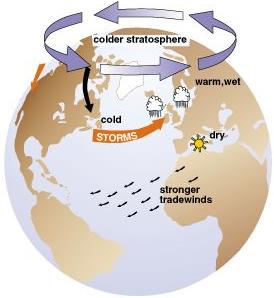It’s cold in New York City. I’m in town for the first module of the Global Executive MBA’s America’s track which starts tomorrow morning. and although I brought my jogging gear, there are very few people running in Central Park today.
Yesterday was the coldest February 14th in 100 years and the average temperature in the city was -18ºC or -1ºF! Happy Valentines day!

The interesting thing about such cold weather is that December was one of the warmest in memory in the City where it got up to 19ºC (66ºF) on Christmas day! The very warm December was blamed on el Niño, a warmer than average current of water in the Pacific.
The cold in New York this weekend and across the Eastern part of the US is due to what is called the Polar Vortex and has brought New Yorkers to attention as the missing Winter showed up with an attitude.
Climate Change ?

The Northern Polar Vortex is a well established pattern of wind that spins around the North Pole in a counter clockwise direction high up in the atmosphere. When the vortex is strong, it forms a relatively tight circular pattern over and around the arctic.
When it is weakened, it sometimes can become “wobbly” and extend southward to touch on Southern Canada and the East Coast of the United States and that is what is happening now.
The same thing happened in 2014 and according to a article posted by from the National Oceanic and Atmospheric Administration (NOOA) such events historically happen every 5-10 years.
The real question is what is causing the Vortex to “wobble” and while the science is far from conclusive, the suspicion is that decreasing polar ice is weakening the vortex and causing these extreme cold periods.
A Warmer Arctic and the Methane Emergency
Their are a number of implications for a warmer arctic such as the opening up the regions vast mineral and oil wealth and changes to shipping patterns which have been discussed in earlier posts.
 What is getting increasing attention is the concern that slight temperature increases in the arctic can begin to melt the permafrost that covers much of the northern part of the planet and that melting permafrost will release millions of tons of methane into the atmosphere. Methane, like CO2 is a greenhouse gas and has a reportedly stronger effect on the process of global warming.
What is getting increasing attention is the concern that slight temperature increases in the arctic can begin to melt the permafrost that covers much of the northern part of the planet and that melting permafrost will release millions of tons of methane into the atmosphere. Methane, like CO2 is a greenhouse gas and has a reportedly stronger effect on the process of global warming.
According to the Arctic Methane Emergency Group, we are facing a runaway situation in the Arctic which may cause global temperatures to increase by 6-7 ºC in a time span as short as 10 years due to the dual feedback loops of melting arctic ice and the release of arctic methane.
Besides the permafrost, if arctic waters became warm enough, then frozen methane hydrates might begin to warm releasing even more methane. Hydrates are crystalline structures on the sea bed and are currently the topic of intense speculation as a possible energy source for the future.
Methane is essentially natural gas which has a lower carbon footprint than oil and coal and if harvested safely, methane hydrates could provide the world with relatively clean energy for as long as it takes to develop even cleaner technology such as advanced solar or even nuclear fusion.
Growing up near New york city, I remember warm summers and cold snowy winters. My guess is that this season is an example of what has been called global weirding and I am afraid we just have to get used to the weather getting weird.


amazing…
Thank you very much for offering this good explanation of the Polar Vortex wind and the impact of global warming on our lives. I guess we need more good articles- like yours- to realize the huge consequences of global warming on human lives, as well as the wild life. Recently, I read an article concluded that global warming has allowed polar bears to venture to habitats they don’t usually occupy. Thank you for raising the awareness on this vital issue.